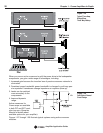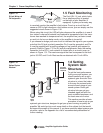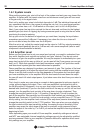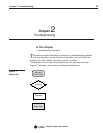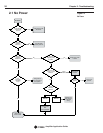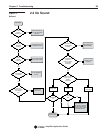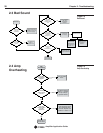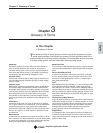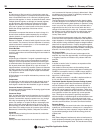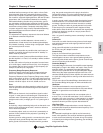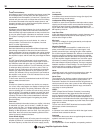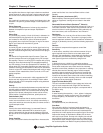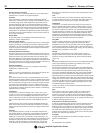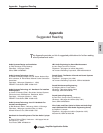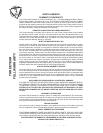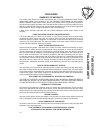
Chapter 3: Glossary of Terms 29
English
Amplifi er Application Guide
manifests itself as some type of hum, static, or buzz. Such
electromagnetic fi elds are produced by fl uorescent lights,
power lines, computers, automobile ignition systems, televi-
sion monitors, solid state lighting dimmers, AM and FM radio
transmitters, and TV transmitters. Methods for controlling
EMI include shielding of audio wiring and devices, ground-
ing, elimination of ground loops, balancing of audio circuits,
twisting of wires in balanced transmission lines, and isolation
transformers among others. Completely eliminating EMI in
a system ranges from easy to nearly impossible depending
upon the equipment and the environment in question.
Equalization (EQ)
The adjustment of frequency response to alter tonal balance
or to attenuate unwanted frequencies.
Fader
Another name for variable attenuator, volume control, or
potentiometer. A fader works like a standard potentiometer,
only instead of rotating, it slides along a straight path. Faders
are commonly found on mixers.
Fault
A term used to describe any condition that could cause an
amplifi er or amplifi er channel to place itself in “standby” or
offl ine mode for protection.
An indicator on some Crown amplifi ers that blinks to show
that the amplifi er is in “Fault,” or a standby or offl ine condition.
Frequency
In audio, the number of cycles per second of a sound wave
of an audio signal, measured in hertz (Hz). A low frequency
(for example 100 Hz) has a low pitch; a high frequency (for
example 10,000 Hz) has a high pitch.
Frequency Range/Frequency Response
Frequency Range is the actual span of frequencies that a
device can reproduce, for example from 5 Hz to 22 kHz.
Frequency Response is the Frequency Range versus Ampli-
tude. In other words, at 20 Hz, a certain input signal level may
produce 100 dB of output. At 1 kHz, that same input level may
produce 102 dB of output. At 10 kHz, 95 dB, and so on.
Fuse
A device intended to provide protection to electrical circuits.
It burns open when current fl ows though it that exceeds its
current rating.
Gain
How much an electronic circuit amplifi es a signal is called
its “gain.” In most specs or references gain is expressed as
a decibel value. Occasionally gain may be expressed as a
straight numeric ratio (a voltage gain of 4 or a power gain of
2).
Ground
In electricity, a large conducting body, such as the earth or an
electric circuit connected to the earth, used as a reference
zero of electrical potential.
A conducting object, such as a wire, that is connected to a
position of zero potential for the purpose of “grounding” an
electronic device.
A power ground or safety ground is a connection to the power
company’s earth ground through the power outlet. In the
power ground of an electronic component with a grounded
plug, the ground connection on the plug is wired to the
component’s chassis. This wire conducts electricity to power
ground if the chassis becomes electrically “hot,” preventing
electrical shock.
In audio, ground usually refers to either the electrical ground
mentioned above, or to an audio shield. An audio shield is
not always a ground and should never be used as a safety
ground. That they are often at ground potential is a function
of how they may be connected to other equipment. Many
audio devices have the ability to disconnect their signal paths
entirely from electrical ground as a way to prevent hum or
ground loop problems.
Verb - to “ground” something means connecting it electrically
to ground.
Ground Lift
Ground lift is a switch found on many pieces of audio equip-
ment which disconnects audio signal ground from earth or
chassis ground.
Using ground lift switches is considered to be far safer than
the “3-to-2 prong AC adapter” solution.
Ground Loop
A loop or circuit formed from ground leads.
The loop formed when unbalanced components are con-
nected together via two or more ground paths–typically the
connecting-cable shield and the power ground. Ground loops
cause hum and should be avoided.
Grounded Bridge™
Grounded Bridge is the name of an amplifi er output topology
developed by Crown in the 1980’s, and used in many Crown
amplifi er models. The patented Grounded Bridge design
consists of four quadrants and an ungrounded power supply.
While two of the output quadrants operate much like a con-
ventional (AB+B push-pull) linear amplifi er, the other two work
in a push-pull confi guration to control ground reference for the
supply rails.
To learn more about Grounded Bridge, download and read
the Grounded Bridge white paper at www.crownaudio.com.
Headroom
The difference between the normal operating level of a
device, and the maximum level that device can pass without
distortion. In general the more headroom the better.
Hertz
The inverse of the time required for one complete cycle of
a wave. Thus, a 10 Hz sine wave takes 1/10 of a second to
complete a full cycle. In practice, it is the frequency or number
of wave cycles occurring per second. In the audio range this
equates to what we perceive as pitch. Abbreviated Hz.
High-Pass Filter
A fi lter that passes frequencies above a certain frequency
and attenuates frequencies below that same frequency. It can
also be called a low-cut fi lter.
Hum
An unwanted low-pitched tone (60 Hz and its harmonics)
heard in the speakers. The sound of interference generated
in audio circuits and cables by AC power wiring. Hum pickup
is caused by such things as faulty grounding, poor shielding,
and ground loops.



